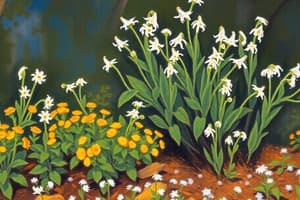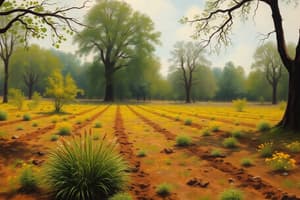Podcast
Questions and Answers
Which cation is NOT typically involved in cation exchange as depicted?
Which cation is NOT typically involved in cation exchange as depicted?
- HCO3- (correct)
- K+
- Mg2+
- Na+
What role does H+ play in the cation exchange process?
What role does H+ play in the cation exchange process?
- It replaces anionic species in exchange sites.
- It competes with cations for exchange sites. (correct)
- It directly combines with cations to form complexes.
- It neutralizes the positive charge of other cations.
Which of the following pairs represents an interaction between cations and anions depicted in the content?
Which of the following pairs represents an interaction between cations and anions depicted in the content?
- Al3+ and NO3-
- Na+ and HCO3-
- Ca2+ and SO42- (correct)
- Mg2+ and Cl-
Which cation likely has the strongest affinity for exchange sites based on charge and size?
Which cation likely has the strongest affinity for exchange sites based on charge and size?
What is the significance of clay micelles in the cation exchange process?
What is the significance of clay micelles in the cation exchange process?
Which of the following ions has a valence charge of +3?
Which of the following ions has a valence charge of +3?
What happens to NH4+ during cation exchange in soil?
What happens to NH4+ during cation exchange in soil?
Which ion is most likely to increase soil acidity when exchanged?
Which ion is most likely to increase soil acidity when exchanged?
Flashcards are hidden until you start studying
Study Notes
Cation Exchange Process
- Important for soil fertility, allowing nutrients to be available for plant uptake.
- Clay micelles play a crucial role in ion exchange due to their negatively charged surfaces, attracting cations.
Key Cations Involved
- NH4+ (Ammonium): Readily exchanged in the soil and crucial for plant growth.
- Al3+ (Aluminum): Can be toxic to plants in high concentrations but is a significant cation in acidic soils.
- Mg2+ (Magnesium): Essential for photosynthesis and chlorophyll production, balanced levels are necessary for healthy plants.
- Ca2+ (Calcium): Important for cell wall structure and signaling in plants; helps with nutrient transport.
- K+ (Potassium): Vital for enzymatic processes and water regulation in plants.
Anions Present
- HCO3- (Bicarbonate): Involved in buffering capacity of soil and can affect nutrient availability.
- NO3- (Nitrate): Major nitrogen source for plants; its availability is influenced by the soil's cation exchange capacity.
- SO42- (Sulfate): Essential for protein synthesis and enzyme function.
Mechanisms of Exchange
- Cation exchange involves the swapping of different cations on the clay micelles through processes influenced by soil pH.
- H+ ions play a significant role in displacing other cations from the micelles, indicating the importance of acidic conditions for nutrient availability.
Environmental Impact
- Soil composition affects the cation exchange capacity, influencing agricultural practices and environmental sustainability.
- The balance of cations and anions is crucial in preventing nutrient leaching and ensuring soil health.
Studying That Suits You
Use AI to generate personalized quizzes and flashcards to suit your learning preferences.




